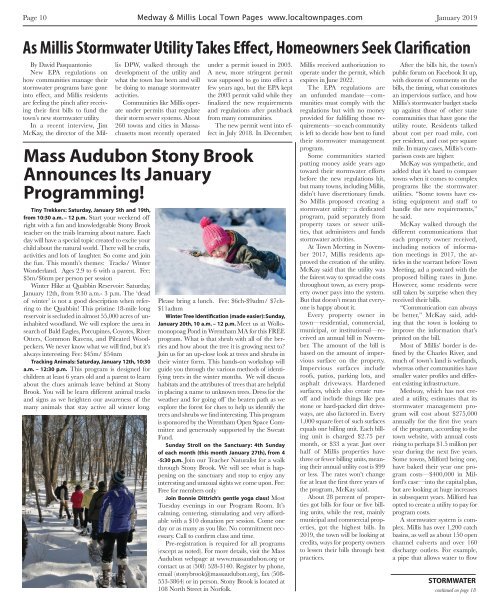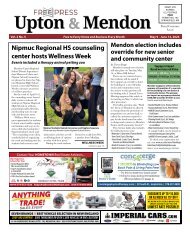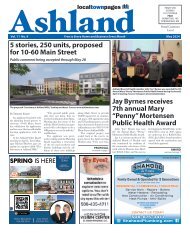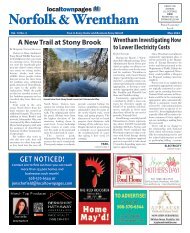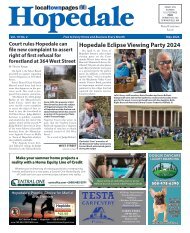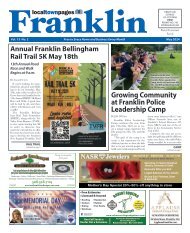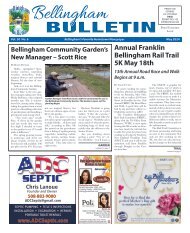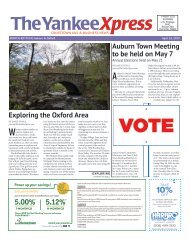Create successful ePaper yourself
Turn your PDF publications into a flip-book with our unique Google optimized e-Paper software.
Page 10 <strong>Medway</strong> & <strong>Millis</strong> Local Town Pages www.localtownpages.com <strong>January</strong> <strong>2019</strong><br />
As <strong>Millis</strong> Stormwater Utility Takes Effect, Homeowners Seek Clarification<br />
By David Pasquantonio<br />
New EPA regulations on<br />
how communities manage their<br />
stormwater programs have gone<br />
into effect, and <strong>Millis</strong> residents<br />
are feeling the pinch after receiving<br />
their first bills to fund the<br />
town’s new stormwater utility.<br />
In a recent interview, Jim<br />
McKay, the director of the <strong>Millis</strong><br />
DPW, walked through the<br />
development of the utility and<br />
what the town has been and will<br />
be doing to manage stormwater<br />
activities.<br />
Communities like <strong>Millis</strong> operate<br />
under permits that regulate<br />
their storm sewer systems. About<br />
260 towns and cities in Massachusetts<br />
most recently operated<br />
under a permit issued in 2003.<br />
A new, more stringent permit<br />
was supposed to go into effect a<br />
few years ago, but the EPA kept<br />
the 2003 permit valid while they<br />
finalized the new requirements<br />
and regulations after pushback<br />
from many communities.<br />
The new permit went into effect<br />
in July 2018. In December,<br />
Mass Audubon Stony Brook<br />
Announces Its <strong>January</strong><br />
Programming!<br />
Tiny Trekkers: Saturday, <strong>January</strong> 5th and 19th,<br />
from 10:30 a.m. – 12 p.m. Start your weekend off<br />
right with a fun and knowledgeable Stony Brook<br />
teacher on the trails learning about nature. Each<br />
day will have a special topic created to excite your<br />
child about the natural world. There will be crafts,<br />
activities and lots of laughter. So come and join<br />
the fun. This month’s themes: Tracks/ Winter<br />
Wonderland. Ages 2.9 to 6 with a parent. Fee:<br />
$5m/$6nm per person per session<br />
Winter Hike at Quabbin Reservoir: Saturday,<br />
<strong>January</strong> 12th, from 9:30 a.m.- 3 p.m. The ‘dead<br />
of winter’ is not a good description when referring<br />
to the Quabbin! This pristine 18-mile long<br />
reservoir is secluded in almost 55,000 acres of uninhabited<br />
woodland. We will explore the area in<br />
search of Bald Eagles, Porcupines, Coyotes, River<br />
Otters, Common Ravens, and Pileated Woodpeckers.<br />
We never know what we will find, but it’s<br />
always interesting. Fee: $45m/ $54nm<br />
Tracking Animals: Saturday, <strong>January</strong> 12th, 10:30<br />
a.m. – 12:30 p.m. This program is designed for<br />
children at least 6 years old and a parent to learn<br />
about the clues animals leave behind at Stony<br />
Brook. You will be learn different animal tracks<br />
and signs as we heighten our awareness of the<br />
many animals that stay active all winter long.<br />
Please bring a lunch. Fee: $6ch-$9adm/ $7ch-<br />
$11adnm<br />
Winter Tree Identification (made easier): Sunday,<br />
<strong>January</strong> 20th, 10 a.m. – 12 p.m. Meet us at Wollomonopoag<br />
Pond in Wrentham MA for this FREE<br />
program. What is that shrub with all of the berries<br />
and how about the tree it is growing next to?<br />
Join us for an up-close look at trees and shrubs in<br />
their winter form. This hands-on workshop will<br />
guide you through the various methods of identifying<br />
trees in the winter months. We will discuss<br />
habitats and the attributes of trees that are helpful<br />
in placing a name to unknown trees. Dress for the<br />
weather and for going off the beaten path as we<br />
explore the forest for clues to help us identify the<br />
trees and shrubs we find interesting. This program<br />
is sponsored by the Wrentham Open Space Committee<br />
and generously supported by the Sweatt<br />
Fund.<br />
Sunday Stroll on the Sanctuary: 4th Sunday<br />
of each month (this month <strong>January</strong> 27th), from 4<br />
-5:30 p.m. Join our Teacher Naturalist for a walk<br />
through Stony Brook. We will see what is happening<br />
on the sanctuary and stop to enjoy any<br />
interesting and unusual sights we come upon. Fee:<br />
Free for members only<br />
Join Bonnie Dittrich’s gentle yoga class! Most<br />
Tuesday evenings in our Program Room. It’s<br />
calming, centering, stimulating and very affordable<br />
with a $10 donation per session. Come one<br />
day or as many as you like. No commitment necessary.<br />
Call to confirm class and time.<br />
Pre-registration is required for all programs<br />
(except as noted). For more details, visit the Mass<br />
Audubon webpage at www.massaudubon.org or<br />
contact us at (508) 528-3140. Register by phone,<br />
email (stonybrook@massaudubon.org), fax (508-<br />
553-3864) or in person. Stony Brook is located at<br />
108 North Street in Norfolk.<br />
<strong>Millis</strong> received authorization to<br />
operate under the permit, which<br />
expires in June 2022.<br />
The EPA regulations are<br />
an unfunded mandate—communities<br />
must comply with the<br />
regulations but with no money<br />
provided for fulfilling those requirements—so<br />
each community<br />
is left to decide how best to fund<br />
their stormwater management<br />
program.<br />
Some communities started<br />
putting money aside years ago<br />
toward their stormwater efforts<br />
before the new regulations hit,<br />
but many towns, including <strong>Millis</strong>,<br />
didn’t have discretionary funds.<br />
So <strong>Millis</strong> proposed creating a<br />
stormwater utility—a dedicated<br />
program, paid separately from<br />
property taxes or sewer utilities,<br />
that administers and funds<br />
stormwater activities.<br />
At Town Meeting in November<br />
2017, <strong>Millis</strong> residents approved<br />
the creation of the utility.<br />
McKay said that the utility was<br />
the fairest way to spread the costs<br />
throughout town, as every property<br />
owner pays into the system.<br />
But that doesn’t mean that everyone<br />
is happy about it.<br />
Every property owner in<br />
town—residential, commercial,<br />
municipal, or institutional—received<br />
an annual bill in November.<br />
The amount of the bill is<br />
based on the amount of impervious<br />
surface on the property.<br />
Impervious surfaces include<br />
roofs, patios, parking lots, and<br />
asphalt driveways. Hardened<br />
surfaces, which also create runoff<br />
and include things like pea<br />
stone or hard-packed dirt driveways,<br />
are also factored in. Every<br />
1,000 square feet of such surfaces<br />
equals one billing unit. Each billing<br />
unit is charged $2.75 per<br />
month, or $33 a year. Just over<br />
half of <strong>Millis</strong> properties have<br />
three or fewer billing units, meaning<br />
their annual utility cost is $99<br />
or less. The rates won’t change<br />
for at least the first three years of<br />
the program, McKay said.<br />
About 28 percent of properties<br />
got bills for four or five billing<br />
units, while the rest, mainly<br />
municipal and commercial properties,<br />
got the highest bills. In<br />
<strong>2019</strong>, the town will be looking at<br />
credits, ways for property owners<br />
to lessen their bills through best<br />
practices.<br />
After the bills hit, the town’s<br />
public forum on Facebook lit up,<br />
with dozens of comments on the<br />
bills, the timing, what constitutes<br />
an impervious surface, and how<br />
<strong>Millis</strong>’s stormwater budget stacks<br />
up against those of other state<br />
communities that have gone the<br />
utility route. Residents talked<br />
about cost per road mile, cost<br />
per resident, and cost per square<br />
mile. In many cases, <strong>Millis</strong>’s comparison<br />
costs are higher.<br />
McKay was sympathetic, and<br />
added that it’s hard to compare<br />
towns when it comes to complex<br />
programs like the stormwater<br />
utilities. “Some towns have existing<br />
equipment and staff to<br />
handle the new requirements,”<br />
he said.<br />
McKay walked through the<br />
different communications that<br />
each property owner received,<br />
including notices of information<br />
meetings in 2017, the articles<br />
in the warrant before Town<br />
Meeting, ad a postcard with the<br />
proposed billing rates in June.<br />
However, some residents were<br />
still taken by surprise when they<br />
received their bills.<br />
“Communication can always<br />
be better,” McKay said, adding<br />
that the town is looking to<br />
improve the information that’s<br />
printed on the bill.<br />
Most of <strong>Millis</strong>’ border is defined<br />
by the Charles River, and<br />
much of town’s land is wetlands,<br />
whereas other communities have<br />
smaller water profiles and different<br />
existing infrastructure.<br />
<strong>Medway</strong>, which has not created<br />
a utility, estimates that its<br />
stormwater management program<br />
will cost about $275,000<br />
annually for the first five years<br />
of the program, according to the<br />
town website, with annual costs<br />
rising to perhaps $1.5 million per<br />
year during the next five years.<br />
Some towns, Milford being one,<br />
have baked their year one program<br />
costs—$400,000 in Milford’s<br />
case—into the capital plan,<br />
but are looking at huge increases<br />
in subsequent years. Milford has<br />
opted to create a utility to pay for<br />
program costs.<br />
A stormwater system is complex.<br />
<strong>Millis</strong> has over 1,200 catch<br />
basins, as well as about 150 open<br />
channel culverts and over 160<br />
discharge outlets. For example,<br />
a pipe that allows water to flow<br />
STORMWATER<br />
continued on page 18


